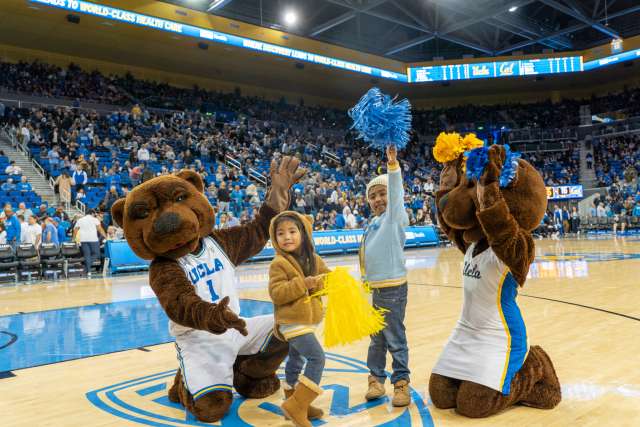The roar of the capacity crowd inside UCLA’s Pauley Pavilion could not distract 8-year-old Rainen Valeriano from his huge moment: seeing himself on the big screen above center court.
Sure, he sat courtside during warmups and passed a basketball to UCLA freshman guard Jack Seidler, who went on to sink a three-pointer. And, yes, Rainen posed for photos with UCLA mascots Joe and Josie Bruin.
But at halftime during the Bruins’ matchup against UC Berkeley back in February, when the announcer introduced Rainen and his 4-year-old sister, Myla, as “Kid Captains,” a camera beamed their image onto the big screen for all to see.
“That was my favorite,” said Rainen, clutching the pom-pom he’d held onto throughout the game.
Bone disorder can lead to frequent fractures
It was a memorable night for the Valeriano family, not only because Rainen and Myla were in the spotlight, but because the two youngsters are healthy and thriving despite being diagnosed with osteogenesis imperfecta, a rare genetic bone disorder that can lead to frequent fractures.
Myla was diagnosed in utero, so she started receiving IV infusions to support her bone strength when she was 6 months old.
“She looks and interacts just like a normal kid,” says her father, Art Valeriano. “You would look at her and not even suspect that she would have this bone condition.”
Rainen, however, wasn’t tested for osteogenesis imperfecta until recently. When he chipped a tooth at daycare and broke his leg in preschool — a tibia spiral fracture common in toddlers — his parents chalked it up to him being a rambunctious kid.
But more injuries followed. Rainen pounded on a table in frustration and cracked a bone in his arm — an injury his parents didn’t discover until they noticed he was only using one arm to swim. Another break followed.
“The last straw before diagnostic testing was when he slipped in the bathroom,” Valeriano says. Rainen’s feet were wet after a shower and he fell on the floor.
“He landed on his butt and I could see the pain in his eyes,” Valeriano says. “I just knew something was wrong.”
Art and Desiree Valeriano took their son to urgent care, where an X-ray showed a compression fracture in Rainen’s spine.

That injury prompted their pediatrician, , to suggest Rainen be tested for osteogenesis imperfecta. When results confirmed the diagnosis, Rainen began the same IV infusion treatment Myla received.
“They’re on a bone-building medicine that is similar to how we treat osteoporosis in adults,” Dr. Grossman says. “It’s an IV infusion of bone-building medication called bisphosphonate that actually helps them with strengthening their bones and decreasing fracture risk.”
Dad gets diagnosed too
During a follow-up appointment, another one of the children’s doctors, , professor of Orthopaedic Surgery and Human Genetics at the David Geffen School of Medicine at UCLA, asked Valeriano if he’d been checked for the condition once known as “brittle bone disease.”
“She looked at my eyes, and she said, ‘You have these bluish-grayish eyes that people with (osteogenesis imperfecta) have. Have you ever been tested?” Valeriano recalls.
People with osteogenesis imperfecta to the whites of their eyes.
Valeriano had a number of fractures during childhood but never thought much of the injuries.
“I just thought it was me being a kid and doing contact sports,” he says. “It just comes with the territory.”
Valeriano was tested and subsequently diagnosed with osteogenesis imperfecta at age 42.
It was almost a relief, he says, because it gave him confidence that Rainen and Myla can have the kind of active, normal childhood he did.
“It just makes me feel a little better, knowing that I’ve gone through my whole life (with this condition),” Valeriano says. “At first with Myla, I was very concerned if she was going to have a normal life … and same with Rainen.”
The children don’t appear troubled by their condition or the treatment for it, Dr. Grossman says.
“They’re really fun kids who are not at all impacted by the frequent doctor visits and such,” he says. “It hasn’t affected their overall enjoyment of life, which is great to see.”

Rainen and Myla will receive ongoing bone-density tests to ensure their bones are getting stronger, says Dr. Grossman, who was on hand to witness the Kid Captains celebration.
For the Valerianos, seeing their children grinning and posing at the game was a happy milestone on what has felt like a long journey.
“Words can’t even really describe what it was like to see Rainen’s dream come true,” Art Valeriano says. “When we asked him what he wanted from this experience, he said he wanted to be up on the big screen. So seeing that unfold for him was just incredible.”





